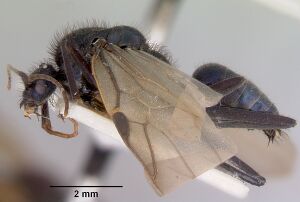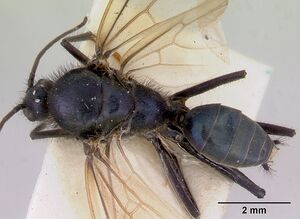Iridomyrmex lividus
| Iridomyrmex lividus | |
|---|---|

| |
| Scientific classification | |
| Kingdom: | Animalia |
| Phylum: | Arthropoda |
| Class: | Insecta |
| Order: | Hymenoptera |
| Family: | Formicidae |
| Subfamily: | Dolichoderinae |
| Tribe: | Leptomyrmecini |
| Genus: | Iridomyrmex |
| Species: | I. lividus |
| Binomial name | |
| Iridomyrmex lividus Shattuck, 1993 | |
Identification
The range of I. lividus overlaps with the closely related Iridomyrmex purpureus. In general, fresh worker material can be distinguished by its dark colour and strong blue iridescence. However, faded specimens can be quite difficult to separate from western samples of I. purpureus, in particular. The rather more angulate form of the propodeum in most I. lividus is a helpful character (this sclerite is more rounded in many I. purpureus), but must be used with caution as it is not universal. In the field, the small, single entrance hole to the I. lividus nest contrasts with the large mound made by its close relative.
Keys including this Species
Distribution
Latitudinal Distribution Pattern
Latitudinal Range: -25.36667° to -35.5°.
| North Temperate |
North Subtropical |
Tropical | South Subtropical |
South Temperate |
- Source: AntMaps
Distribution based on Regional Taxon Lists
Australasian Region: Australia (type locality).
Distribution based on AntMaps
Distribution based on AntWeb specimens
Check data from AntWeb
Countries Occupied
| Number of countries occupied by this species based on AntWiki Regional Taxon Lists. In general, fewer countries occupied indicates a narrower range, while more countries indicates a more widespread species. |

|
Estimated Abundance
| Relative abundance based on number of AntMaps records per species (this species within the purple bar). Fewer records (to the left) indicates a less abundant/encountered species while more records (to the right) indicates more abundant/encountered species. |

|
Biology
Biochemically, this ant shares the frequencies of several allozyme alleles with those of I. purpureus (Halliday, 1979, 1981) although there are differences in competitive abilities between the two species (Greenslade, 1987).
Castes
Queen
Images from AntWeb
   
| |
| Queen (alate/dealate). Specimen code casent0172066. Photographer April Nobile, uploaded by California Academy of Sciences. | Owned by ANIC, Canberra, Australia. |
Male
Images from AntWeb
    
| |
| Male (alate). Specimen code casent0172065. Photographer April Nobile, uploaded by California Academy of Sciences. | Owned by ANIC, Canberra, Australia. |
Nomenclature
The following information is derived from Barry Bolton's Online Catalogue of the Ants of the World.
- lividus. Iridomyrmex lividus Shattuck, 1993a: 125, fig. 12 (w.) AUSTRALIA. See also: Heterick & Shattuck, 2011: 94.
Type Material
- Holotype, worker, Cambrai, South Australia, Australia, Greenslade,P.J.M. & Kirkby,C.A., ANIC32-007720, Australian National Insect Collection.
- Paratype, 20 workers, Cambrai, South Australia, Australia, Greenslade,P.J.M. & Kirkby,C.A., ANIC32-007719, Australian National Insect Collection.
- Paratype, 27 workers, Cambrai, South Australia, Australia, Greenslade,P.J.M. & Kirkby,C.A., ANIC32-014994, Australian National Insect Collection.
- Paratype, 24 workers, Cambrai, South Australia, Australia, Greenslade,P.J.M. & Kirkby,C.A., ANIC32-015068, Australian National Insect Collection.
- Paratype, 24 workers, Cambrai, South Australia, Australia, Greenslade,P.J.M. & Kirkby,C.A., ANIC32-015072, Australian National Insect Collection.
- Paratype, 11 workers, Cambrai, South Australia, Australia, The Natural History Museum.
- Paratype, 11 workers, Cambrai, South Australia, Australia, Museum of Comparative Zoology.
Description
Worker Description. Head. Posterior margin of head planar to weakly concave; erect setae on posterior margin in full-face view set in a row; sides of head noticeably convex; erect genal setae absent from sides of head in full-face view (one to a few small setae may be present near mandibular insertion). Ocelli absent; in full-face view, eyes set above midpoint of head capsule; in profile, eye set anteriad of head capsule; eye semi-circular. Frontal carinae convex; antennal scape surpassing posterior margin of head by approximately 2 x its diameter. Erect setae on scape present and abundant; prominence on anteromedial clypeal margin projecting as triangular spur; mandible elongate triangular with oblique basal margin; long, curved setae on venter of head capsule present. Mesosoma. Pronotum moderately and evenly curved over its length. Erect pronotal setae numerous (12 or more), short and bristly. Mesonotum sinuous. Erect mesonotal setae numerous (12 or more), short and bristly. Mesothoracic spiracles always prominent as small, vertical protuberances; propodeal dorsum protuberant; placement of propodeal spiracle posteriad and near propodeal declivity, or mesad, more than its diameter away from propodeal declivity; propodeal angle present as a bluntly defined right angle, the dorsal and declivitous propodeal faces never separated by a carina, or weakly present or absent, the confluence of the dorsal and declivitous propodeal faces indicated, if at all, by an undulation. Erect propodeal setae numerous (12 or more), short and bristly. Petiole. Dorsum of node acuminate; node thick, orientation more-or-less vertical. Gaster. Non-marginal erect setae of gaster present on first gastral tergite; marginal erect setae of gaster present on first tergite. General characters. Allometric differences between workers of same nest absent. Colour head, appendages and mesosoma reddish-brown to blackish-brown with blue or purple iridescence, gaster chocolate to black with variable blue, greenish, pink or purple iridescence. Colour of erect setae brown.
Measurements. Worker (n = 31)—CI 87–99; EI 17–22; EL 0.31–0.38; EW 0.19–0.23; HL 1.75–2.15; HW 1.58–2.12; ML 0.77–1.02; PpH 0.23–0.38; PpL 0.82–1.13; SI 85–101; SL 1.51–1.84.
References
- Buxton, J.T., Robert, K.A., Marshall, A.T., Dutka, T.L., Gibb, H. 2021. A cross-species test of the function of cuticular traits in ants (Hymenoptera: Formicidae). Myrmecological News 31: 31-46 (doi:10.25849/MYRMECOL.NEWS_031:031).
- Cantone S. 2018. Winged Ants, The queen. Dichotomous key to genera of winged female ants in the World. The Wings of Ants: morphological and systematic relationships (self-published).
- Heterick, B.E. & Shattuck, S.O. 2011. Revision of the ant genus Iridomyrmex (Hymenoptera: Formicidae). Zootaxa 2845: 1-175.
- Heterick, B.E. 2021. A guide to the ants of Western Australia. Part I: Systematics. Records of the Western Australian Museum, Supplement 86, 1-245 (doi:10.18195/issn.0313-122x.86.2021.001-245).
- Heterick, B.E. 2022. A guide to the ants of Western Australia. Part II: Distribution and biology. Records of the Western Australian Museum, supplement 86: 247-510 (doi:10.18195/issn.0313-122x.86.2022.247-510).
- Shattuck, S. O. 1993a. Revision of the Iridomyrmex purpureus species-group (Hymenoptera: Formicidae). Invertebr. Taxon. 7: 113-149 (page 125, fig. 12 worker described)
References based on Global Ant Biodiversity Informatics
- CSIRO Collection
- Heterick B. E., and S. Shattuck. 2011. Revision of the ant genus Iridomyrmex (Hymenoptera: Formicidae). Zootaxa 2845: 1-174.
- Shattuck S. O. 1993. Revision of the Iridomyrmex purpureus species-group (Hymenoptera: Formicidae). Invertebrate Taxonomy 7: 113-149.

